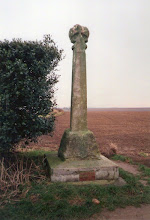I have finally finished off my Early Bulgars (III/14 b) made up mostly of Essex figures (their DBA army pack). The light horse for the a-list are currently half-painted. The army includes one stand of Irregular Turk/Arab heavy cavalry which will have to do until I can order some more Bulgars from Essex.
The 3Cv unit of Bulgars (Essex) display the trident tamga (arms) of the Dulo Clan on their shields to which belonged the great Kahn Krum:
- Krum was Khan of Bulgaria, from after 796, but before 803, to 814 AD. During his reign the Bulgarian territory doubled in size, spreading from the middle Danube to the Dnieper and from Odrin to the Tatra Mountains (Wiki).
The Early Bulgars take the field:

Kahn Krum (3Cv - Gen) leads his mounted troops:

Bulgar/Slavic foot troops (4 x 3Ax and 1 x Ps) in bad going:

The army saw my first use of a Magic Wash recipe I found on Fanaticus. Moderately good shading resulted but still needs some fine tuning. Instead of water soluble ink I used Vallejo pigments to colour the floor wax/water mixture.
BUA and camp to come.
They took to the field for the first time recently and gave my old adversary the Alans' a good run for their money but unfortunately the final clash of our mounted troops saw my 3Cv (Gen) destroyed by the Alan knights. Next time for sure.













